Mixed valency in ligand-bridged diruthenium frameworks: divergences and perspectives
- PMID: 35547993
- PMCID: PMC9084559
- DOI: 10.1039/c8ra03206h
Mixed valency in ligand-bridged diruthenium frameworks: divergences and perspectives
Abstract
The present review article illustrates the mixed valence aspects of ligand-bridged symmetric and unsymmetric diruthenium complexes beyond the textbook example of the Creutz-Taube ion as well as the Robin and Day classification by citing representative examples based on our recent observations. The consideration of varied coordination situations involving bridging and ancillary ligands of diverse electronic and steric demands extended important fundamental events including (i) the influence of ancillary ligands besides the bridge in the intermetallic coupling process, (ii) varying profile of the intervalence charge transfer (IVCT) transition in RuIIIRuII (d5d6) and RuIIIRuIV (d5d4) mixed valence set up, (iii) divergence between the electrochemical (K c = comproportionation constant) and electronic (IVCT) coupling and (iv) occurrence of the hybrid class II-class III situation. Furthermore, additional challenges due to the introduction of redox non-innocent ligands in assigning valence and spin distributions at the metal-ligand interface as well as in differentiating the emerging alternatives of the radical-derived state and the mixed valence situation along the redox chain have been addressed.
This journal is © The Royal Society of Chemistry.
Conflict of interest statement
There are no conflicts to declare.
Figures




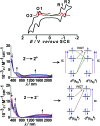
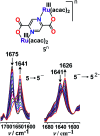
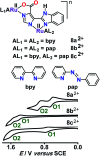



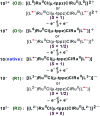
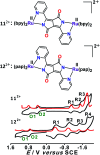

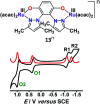





Similar articles
-
Influence of ancillary ligands on the electronic structure and anion sensing features of ligand bridged diruthenium complexes.Dalton Trans. 2013 Oct 7;42(37):13733-46. doi: 10.1039/c3dt50853f. Epub 2013 Aug 1. Dalton Trans. 2013. PMID: 23907254
-
2,2'-Dipyridylketone (dpk) as ancillary acceptor and reporter ligand in complexes [(dpk)(Cl)Ru(mu-tppz)Ru(Cl)(dpk)]n+ where tppz = 2,3,5,6-tetrakis(2-pyridyl)pyrazine.Inorg Chem. 2006 Sep 18;45(19):7955-61. doi: 10.1021/ic060887l. Inorg Chem. 2006. PMID: 16961390
-
Diruthenium and triruthenium compounds of the potential redox active non-chelated η1-N,η1-N-benzothiadiazole bridge.Dalton Trans. 2022 Jun 7;51(22):8657-8670. doi: 10.1039/d2dt00533f. Dalton Trans. 2022. PMID: 35583102
-
Excited State Mixed-Valence Complexes: From the Special Pair to the Creutz-Taube Ion and Beyond.Angew Chem Int Ed Engl. 2023 Apr 3;62(15):e202217082. doi: 10.1002/anie.202217082. Epub 2023 Feb 8. Angew Chem Int Ed Engl. 2023. PMID: 36691301 Review.
-
Exploration of mixed-valence chemistry: inventing new analogues of the Creutz-Taube ion.Acc Chem Res. 2000 Nov;33(11):755-63. doi: 10.1021/ar960067k. Acc Chem Res. 2000. PMID: 11087312 Review.
References
-
- Brown D. B., Mixed Valency Systems—Applications in Chemistry, Physics and Biology, ed. K. Prassides, Kluwer Academic Publishers, Dordrecht, 1991
- Nelsen S. F. Chem.–Eur. J. 2000;6:581. doi: 10.1002/(SICI)1521-3765(20000218)6:4<581::AID-CHEM581>3.0.CO;2-E. - DOI - PubMed
- Aguirre-Etcheverry P. O'Hare D. Chem. Rev. 2010;110:4839. doi: 10.1021/cr9003852. - DOI - PubMed
- Low P. J. Brown N. J. J. Cluster Sci. 2010;21:235. doi: 10.1007/s10876-010-0328-4. - DOI
- Chisholm M. H. Lear B. J. Chem. Soc. Rev. 2011;40:5254. doi: 10.1039/C1CS15061H. - DOI - PubMed
- Hildebrandt A. Lang H. Organometallics. 2013;32:5640. doi: 10.1021/om400453m. - DOI
- Kaim W. Klein A. Glöckle M. Acc. Chem. Res. 2000;33:755. doi: 10.1021/ar960067k. - DOI - PubMed
-
- Miller L. L. Mann K. R. Acc. Chem. Res. 1996;29:417. doi: 10.1021/ar9600446. - DOI
- Sun D.-L. Rosokha S. V. Lindeman S. V. Kochi J. K. J. Am. Chem. Soc. 2003;125:15950. doi: 10.1021/ja037867s. - DOI - PubMed
- Casado J. Takimiya K. Otsubo T. Ramirez F. J. Quirante J. J. Ortiz R. P. Gonzalez S. R. Oliva M. M. Navarrete J. T. L. J. Am. Chem. Soc. 2008;130:14028. doi: 10.1021/ja806207j. - DOI - PubMed
- Cornelis D. Franz E. Asselberghs I. Clays K. Verbiest T. Koeckelberghs G. J. Am. Chem. Soc. 2011;133:1317. doi: 10.1021/ja104978t. - DOI - PubMed
- Jagtap S. P. Mukhopadhyay S. Coropceanum V. Brizius G. L. Bredas J.-L. Collard D. M. J. Am. Chem. Soc. 2012;134:7176. doi: 10.1021/ja3019065. - DOI - PubMed
- Schneebeli S. T. Frasconi M. Liu Z. Wu Y. Gardner D. M. Strutt N. L. Cheng C. Carmieli R. Wasielewski M. R. Stoddart J. F. Angew. Chem., Int. Ed. 2013;52:13100. doi: 10.1002/anie.201307984. - DOI - PubMed
-
- Krewald V. Retegan M. Cox N. Messinger J. Lubitz W. DeBeer S. Neese F. Pantazis D. A. Chem. Sci. 2015;6:1676. doi: 10.1039/C4SC03720K. - DOI - PMC - PubMed
- Klauss A. Haumann M. Dau H. Proc. Natl. Acad. Sci. 2012;109:16035. doi: 10.1073/pnas.1206266109. - DOI - PMC - PubMed
- Roelofs T. A. Liang W. Latimer M. J. Cinco R. M. Rompel A. Andrews J. C. Sauer K. Yachandra V. K. Klein M. P. Proc. Natl. Acad. Sci. 1996;93:3335–3340. doi: 10.1073/pnas.93.8.3335. - DOI - PMC - PubMed
-
- Beinert H. Holm R. H. Münck E. Science. 1997;277:653. doi: 10.1126/science.277.5326.653. - DOI - PubMed
- Subramanian S. Duin E. C. Fawcett S. E. J. Armstrong F. A. Meyer J. Johnson M. K. J. Am. Chem. Soc. 2015;137:4567. doi: 10.1021/jacs.5b01869. - DOI - PMC - PubMed
- Rumpel S. Siebel J. F. Diallo M. FarÀs C. Reijerse E. J. Lubitz W. ChemBioChem. 2015;16:1663–1669. doi: 10.1002/cbic.201500130. - DOI - PubMed
- Pandelia M.-E. Bykov D. Izsak R. Infossi P. Orticoni M.-T. G. Bill E. Neese F. Lubitz W. Proc. Natl. Acad. Sci. 2013;110:483. doi: 10.1073/pnas.1202575110. - DOI - PMC - PubMed
Publication types
LinkOut - more resources
Full Text Sources

